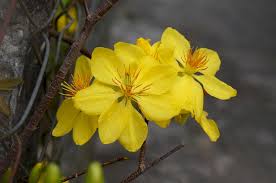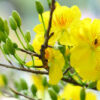**Apricot Blossoms in Music and Poetry**

Apricot Blossoms, with their vibrant colors and delicate fragrance, have inspired artists for centuries, finding their way into the realms of music and poetry. Let’s explore the rich tapestry of melodies and verses that celebrate the beauty and symbolism of Apricot Blossoms.
1. **Musical Odes to Apricot Blossoms:**
Apricot Blossoms have been immortalized in musical compositions across various genres, from classical to folk and contemporary music. In Vietnamese traditional music, melodies such as “Hoa Mai,” “Cherry Blossom,” and “Spring Melody” evoke the spirit of springtime and the blooming of Apricot Blossoms. These enchanting tunes, often accompanied by traditional instruments like the đàn tranh (zither) and đàn bầu (monochord), capture the essence of Apricot Blossoms’ elegance and grace.
2. **Lyricism in Poetry:**
Poets have woven Apricot Blossoms into their verses, imbuing their poetry with the beauty and symbolism of these beloved flowers. From ancient Chinese poets like Li Bai and Du Fu to modern Vietnamese wordsmiths such as Ho Xuan Huong and Nguyen Binh, Apricot Blossoms have served as metaphors for love, renewal, and the transient nature of life. Poetic imagery evokes the sight of Apricot Blossoms in full bloom, their petals fluttering in the breeze, as well as the emotions they evoke in the hearts of admirers.
3. **Symbolism and Cultural Significance:**
Apricot Blossoms hold deep cultural significance in Asian societies, symbolizing prosperity, vitality, and the arrival of spring. In music and poetry, Apricot Blossoms are often associated with themes of renewal, hope, and the cyclical nature of life. Their ephemeral beauty serves as a reminder to cherish the present moment and appreciate the fleeting joys of nature. Through music and poetry, artists convey the timeless allure and profound symbolism of Apricot Blossoms, inspiring audiences to reflect on the beauty of the natural world and the mysteries of existence.
4. **Integration into Performance Arts:**
Apricot Blossoms find expression not only in music and poetry but also in traditional performance arts such as dance, theater, and opera. Performances featuring Apricot Blossom motifs depict scenes from nature, folklore, and mythology, weaving together music, poetry, and visual imagery to create captivating storytelling experiences. Whether portrayed as a backdrop to a romantic serenade or as the centerpiece of a poetic recitation, Apricot Blossoms enhance the aesthetic appeal and emotional depth of performance arts, captivating audiences with their timeless beauty and cultural resonance.
In summary, Apricot Blossoms inspire a symphony of melodies and verses that celebrate their beauty, symbolism, and cultural significance. Through music and poetry, artists evoke the essence of Apricot Blossoms, capturing their ephemeral charm and eternal spirit. As a cherished motif in the arts, Apricot Blossoms continue to captivate audiences with their timeless allure, serving as a source of inspiration and wonder for generations to come.
**The Evocative Presence in Arts:**
Beyond their aesthetic allure, Apricot Blossoms have entrenched themselves as poignant symbols in various art forms, enriching the cultural landscape with their evocative presence.
1. **Musical Elegance:**
Apricot Blossoms evoke a sense of tranquility and serenity in musical compositions across diverse genres. From classical symphonies to contemporary ballads, artists draw inspiration from the delicate beauty of Apricot Blossoms to create melodies that resonate with listeners on an emotional level. The gentle rustle of petals in the wind and the subtle fragrance of Apricot Blossoms find echoes in the ethereal notes of musical instruments, transporting listeners to idyllic landscapes adorned with blooming trees and vibrant blossoms.
2. **Poetic Reverie:**
Poets have long been captivated by the ephemeral beauty and symbolic richness of Apricot Blossoms, weaving them into verses that speak to the human condition and the passage of time. Apricot Blossoms symbolize fleeting moments of beauty and the transient nature of life, inspiring poets to contemplate themes of love, loss, and renewal. Through vivid imagery and lyrical language, poets evoke the sensory experience of encountering Apricot Blossoms in nature, inviting readers to immerse themselves in the timeless beauty of these delicate flowers.
3. **Cultural Reverence:**
In Asian cultures, Apricot Blossoms hold profound cultural significance as symbols of prosperity, vitality, and renewal. Their presence in music and poetry reflects the reverence and admiration they evoke in society, serving as embodiments of cherished values and traditions. Whether depicted in traditional folk songs or revered in classical poetry, Apricot Blossoms symbolize the enduring resilience of the human spirit and the cyclical rhythms of nature, inspiring awe and reverence among audiences.
4. **Interplay with Visual Arts:**
The evocative imagery of Apricot Blossoms finds resonance in visual arts such as painting, calligraphy, and photography. Artists use a variety of mediums and techniques to capture the ephemeral beauty of Apricot Blossoms, from delicate brushstrokes to vibrant color palettes. Through their artistry, they seek to convey the timeless essence of Apricot Blossoms and evoke the emotions they inspire in viewers. Whether depicted as solitary blossoms against a backdrop of blue sky or as part of a bustling springtime landscape, Apricot Blossoms captivate the imagination and evoke a sense of wonder and reverence.
In conclusion, Apricot Blossoms enrich the world of arts with their timeless beauty and symbolic resonance. Through music, poetry, and visual arts, artists pay homage to the ephemeral charm of Apricot Blossoms, celebrating their cultural significance and inviting audiences to contemplate the profound mysteries of nature and existence. As enduring symbols of hope, renewal, and resilience, Apricot Blossoms continue to inspire awe and admiration across generations, leaving an indelible mark on the artistic landscape.


